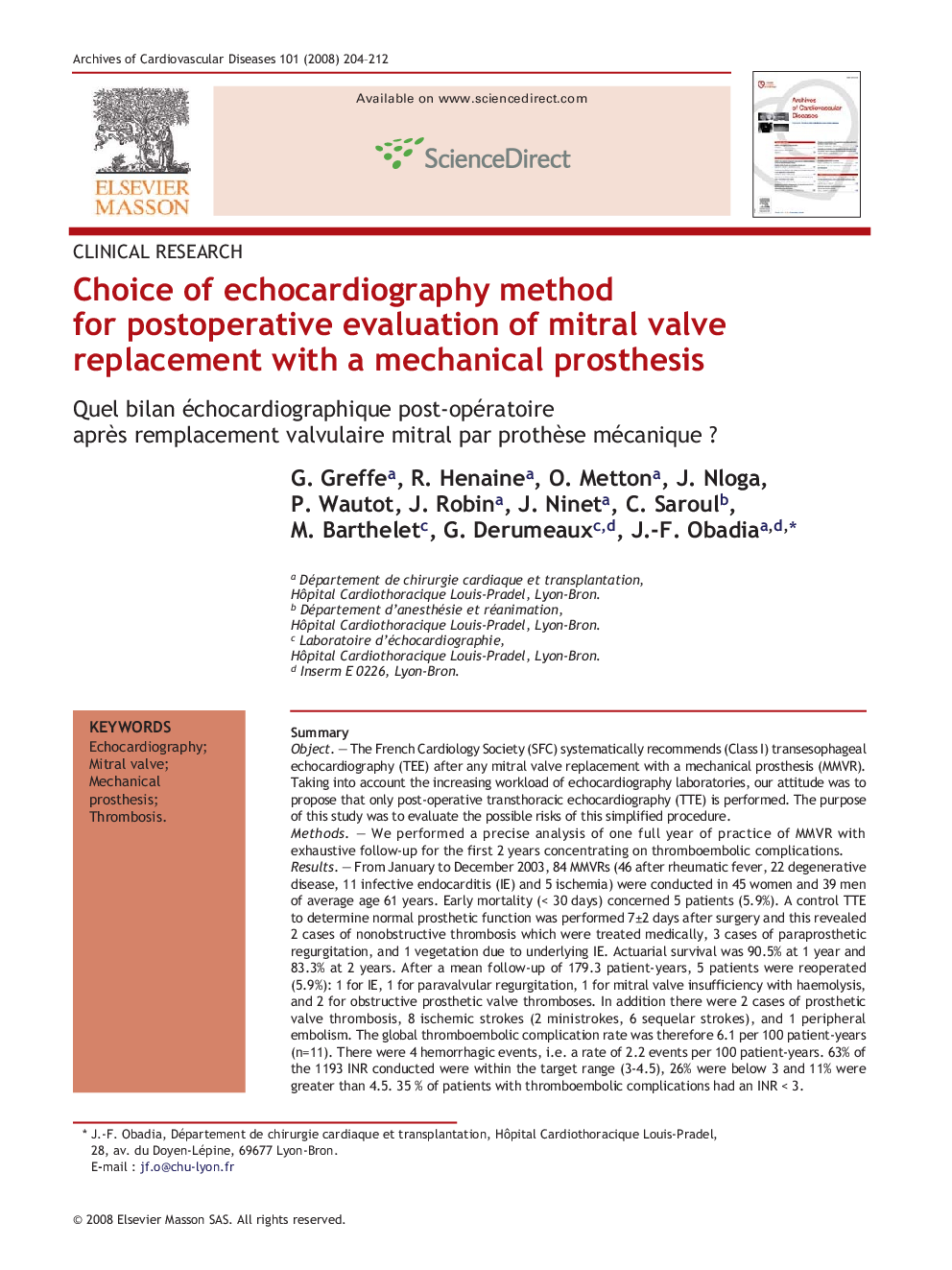| Article ID | Journal | Published Year | Pages | File Type |
|---|---|---|---|---|
| 2890025 | Archives of Cardiovascular Diseases | 2008 | 9 Pages |
SummaryObjectThe French Cardiology Society (SFC) systematically recommends (Class I) transesophageal echocardiography (TEE) after any mitral valve replacement with a mechanical prosthesis (MMVR). Taking into account the increasing workload of echocardiography laboratories, our attitude was to propose that only post-operative transthoracic echocardiography (TTE) is performed. The purpose of this study was to evaluate the possible risks of this simplified procedure.MethodsWe performed a precise analysis of one full year of practice of MMVR with exhaustive follow-up for the first 2 years concentrating on thromboembolic complications.ResultsFrom January to December 2003, 84 MMVRs (46 after rheumatic fever, 22 degenerative disease, 11 infective endocarditis (IE) and 5 ischemia) were conducted in 45 women and 39 men of average age 61 years. Early mortality (< 30 days) concerned 5 patients (5.9%). A control TTE to determine normal prosthetic function was performed 7±2 days after surgery and this revealed 2 cases of nonobstructive thrombosis which were treated medically, 3 cases of paraprosthetic regurgitation, and 1 vegetation due to underlying IE. Actuarial survival was 90.5% at 1 year and 83.3% at 2 years. After a mean follow-up of 179.3 patient-years, 5 patients were reoperated (5.9%): 1 for IE, 1 for paravalvular regurgitation, 1 for mitral valve insufficiency with haemolysis, and 2 for obstructive prosthetic valve thromboses. In addition there were 2 cases of prosthetic valve thrombosis, 8 ischemic strokes (2 ministrokes, 6 sequelar strokes), and 1 peripheral embolism. The global thromboembolic complication rate was therefore 6.1 per 100 patient-years (n=11). There were 4 hemorrhagic events, i.e. a rate of 2.2 events per 100 patient-years. 63% of the 1193 INR conducted were within the target range (3-4.5), 26% were below 3 and 11% were greater than 4.5. 35 % of patients with thromboembolic complications had an INR < 3.ConclusionMorbidity and mortality during the first 2 years after MMVR were relatively high but equivalent to the values of comparable series in the literature. These complications would not have been reduced by a more precise screening based on early TEE. Despite the increasingly litigious nature of the doctor-patient relationship, it would probably be excessive to oppose that this guideline was not followed in a dispute; in particular as it is difficult to apply this measure as echocardiography departments are overworked.
RésuméObjetLa Société Française de Cardiologie (SFC) recommande (classe I) la réalisation d’une échocardiographie trans-œsophagienne (ETO) systématiquement au décours de tout remplacement valvulaire mitral par prothèse mécanique (RVMM). Compte tenu de la surcharge croissante des laboratoires d’échocardiographie, notre attitude est de se contenter uniquement d’une échocardiographie trans-thoracique (ETT) postopératoire et il nous est apparu nécessaire d’évaluer les éventuels risques liés à cette procédure simplifiée.MéthodesNous avons étudié précisément une année complète d’exercice de RVMM avec un suivi exhaustif de 2 ans se concentrant sur les complications thromboemboliques.RésultatsDe janvier à décembre 2003, 84 RVM mécaniques (46 après rhumatisme articulaire, 22 dystrophies, 11 endocardites infectieuses (EI), 5 ischémiques) ont été réalisés chez 45 femmes et 39 hommes d’âge moyen 61 ans. La mortalité précoce (< 30 jours) concernait 5 patients (5,9 %). A 7 ± 2 jours postopératoires, les patients bénéficiaient d’une ETT de contrôle du bon fonctionnement prothétique, ETT qui révélait 2 thromboses non obstructives traitées médicalement, 3 fuites para prothétiques, et 1 végétation dans un contexte d’EI. La survie actuarielle était de 90,5 % à 1 an et de 83,3 % à 2 ans. Avec un recul moyen de 179,3 patient-années, 5 patients (5,9 %) ont été réopérés : 1 pour EI, 1 pour fuite para valvulaire, 1 pour insuffisance mitrale avec hémolyse, et 2 pour thromboses de prothèses obstructives. On notait en plus de ces 2 thromboses de prothèse, 8 AVC ischémiques (2 accidents ischémiques transitoires, 6 accidents séquellaires), et 1 embolie périphérique. Le taux global de complications thromboemboliques était donc de 6,1 pour 100 patient-années (n = 11). On notait 4 événements hémorragiques, soit un taux de 2,2 événements pour 100 patient-années. Sur les 1193 INR réalisés, 63 % étaient dans la cible (3-4,5), 26 % étaient inférieurs à 3 et 11 % étaient supérieurs à 4,5. Chez les patients ayant connu des complications thromboemboliques, on notait 35 % d’INR < 3.ConclusionLa morbi-mortalité après RVMM au cours des 2 premières années est relativement lourde mais équivalente à celle des séries comparables de la littérature. Surtout ces complications n’étaient pas susceptibles d’être diminuées par un dépistage plus précis basé sur une ETO précoce. Compte tenu d’une judiciarisation croissante de la relation médecin-patient, cette recommandation potentiellement opposable en cas de litige pourrait s’avérer excessive et ce d’autant que les disponibilités habituelles des laboratoires d’échographie rend cette mesure difficilement applicable.
